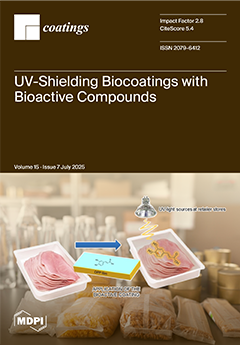To improve implant osseointegration while preventing infection, we developed a strontium (Sr)-doped Ti
3C
2T
x MXene coating on titanium, aiming to synergistically enhance bone integration and antibacterial performance. MXene is a family of two-dimensional transition-metal carbides/nitrides whose abundant surface terminations
[...] Read more.
To improve implant osseointegration while preventing infection, we developed a strontium (Sr)-doped Ti
3C
2T
x MXene coating on titanium, aiming to synergistically enhance bone integration and antibacterial performance. MXene is a family of two-dimensional transition-metal carbides/nitrides whose abundant surface terminations endow high hydrophilicity and bioactivity. The coating was fabricated via anodic electrophoretic deposition (40 V, 2 min) of Ti
3C
2T
x nanosheets, followed by SrCl
2 immersion to incorporate Sr
2+. The coating morphology, phase composition, chemistry, hydrophilicity, mechanical stability, and Sr
2+ release were characterized. In vitro bioactivity was assessed with rat bone marrow mesenchymal stem cells (BMSCs)—with respect to viability, proliferation, migration, alkaline phosphatase (ALP) staining, and Alizarin Red S mineralization—while the antibacterial efficacy was evaluated against
Staphylococcus aureus (
S. aureus) via live/dead staining, colony-forming-unit enumeration, and AlamarBlue assays. The Sr-doped MXene coating formed a uniform lamellar structure, lowered the water-contact angle to ~69°, and sustained Sr
2+ release (0.36–1.37 ppm). Compared to undoped MXene, MXene/Sr enhanced BMSC proliferation on day 5, migration by 51%, ALP activity and mineralization by 47%, and reduced S. aureus viability by 49% within 24 h. Greater BMSCs activity accelerates early bone integration, whereas rapid bacterial suppression mitigates peri-implant infection—two critical requirements for implant success. Sr-doped Ti
3C
2T
x MXene thus offers a simple, dual-function surface-engineering strategy for dental and orthopedic implants.
Full article





